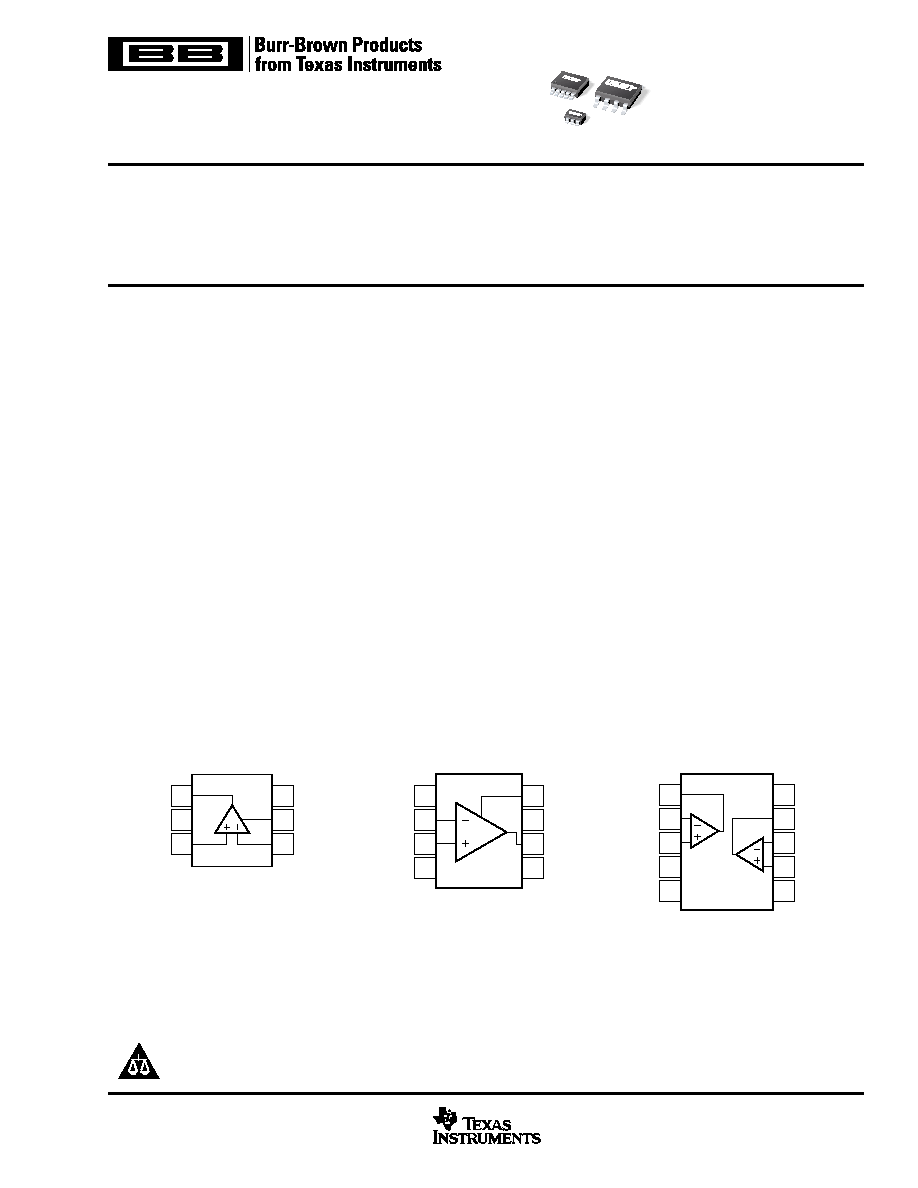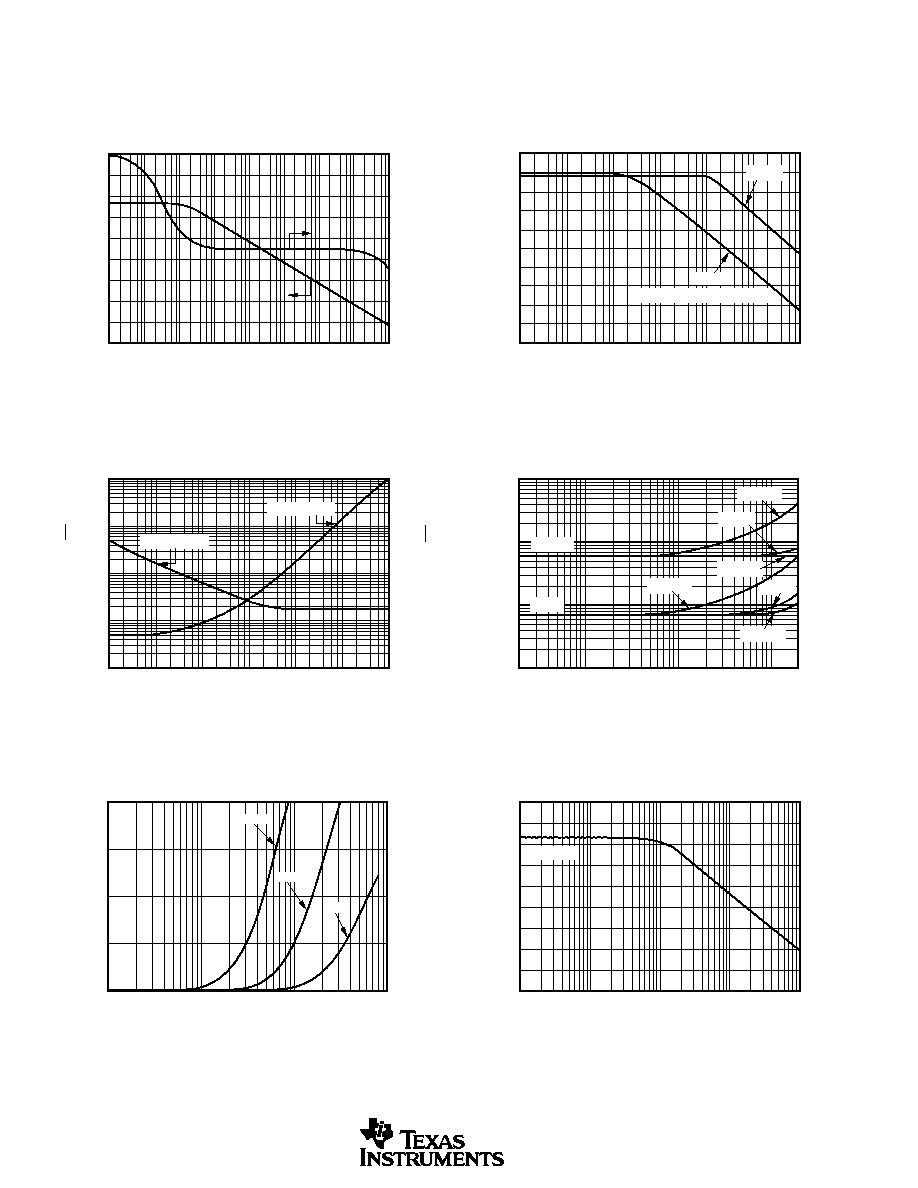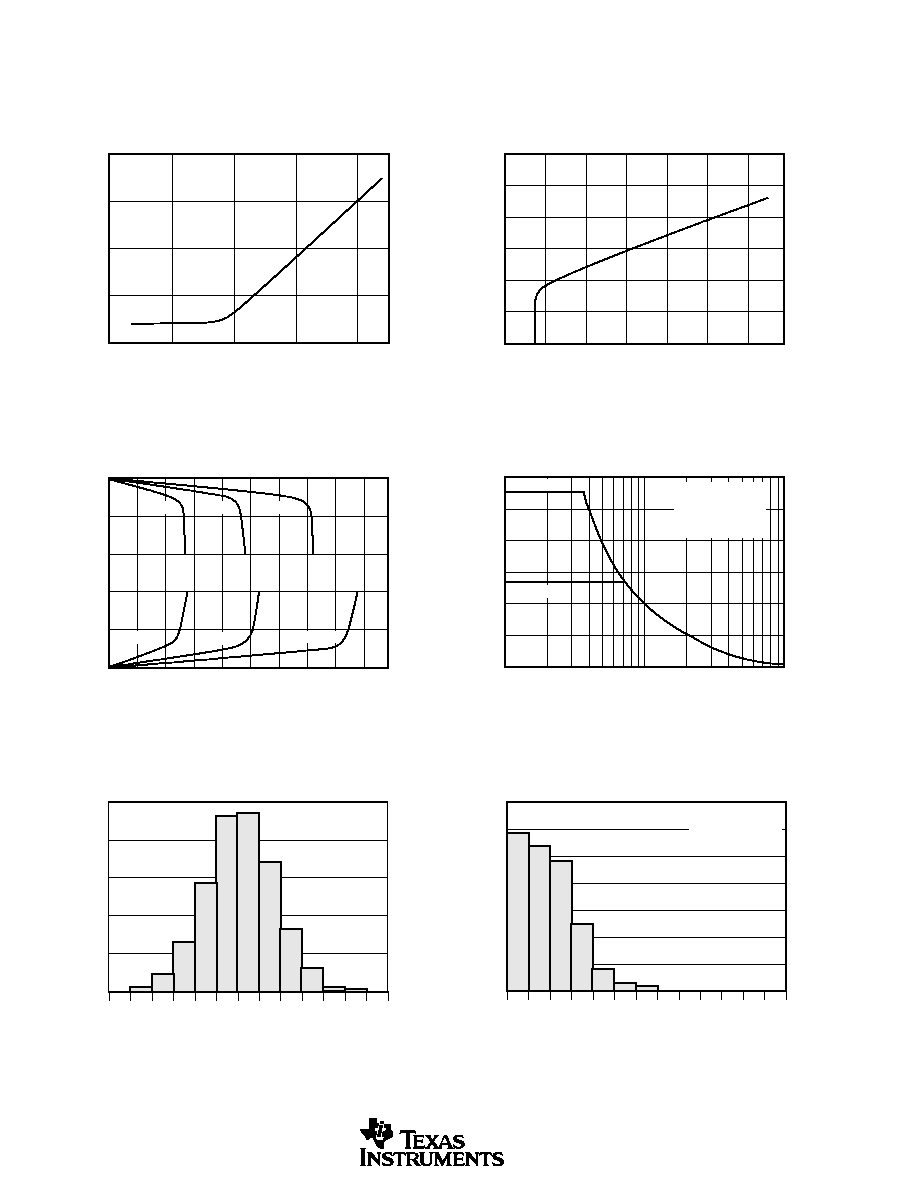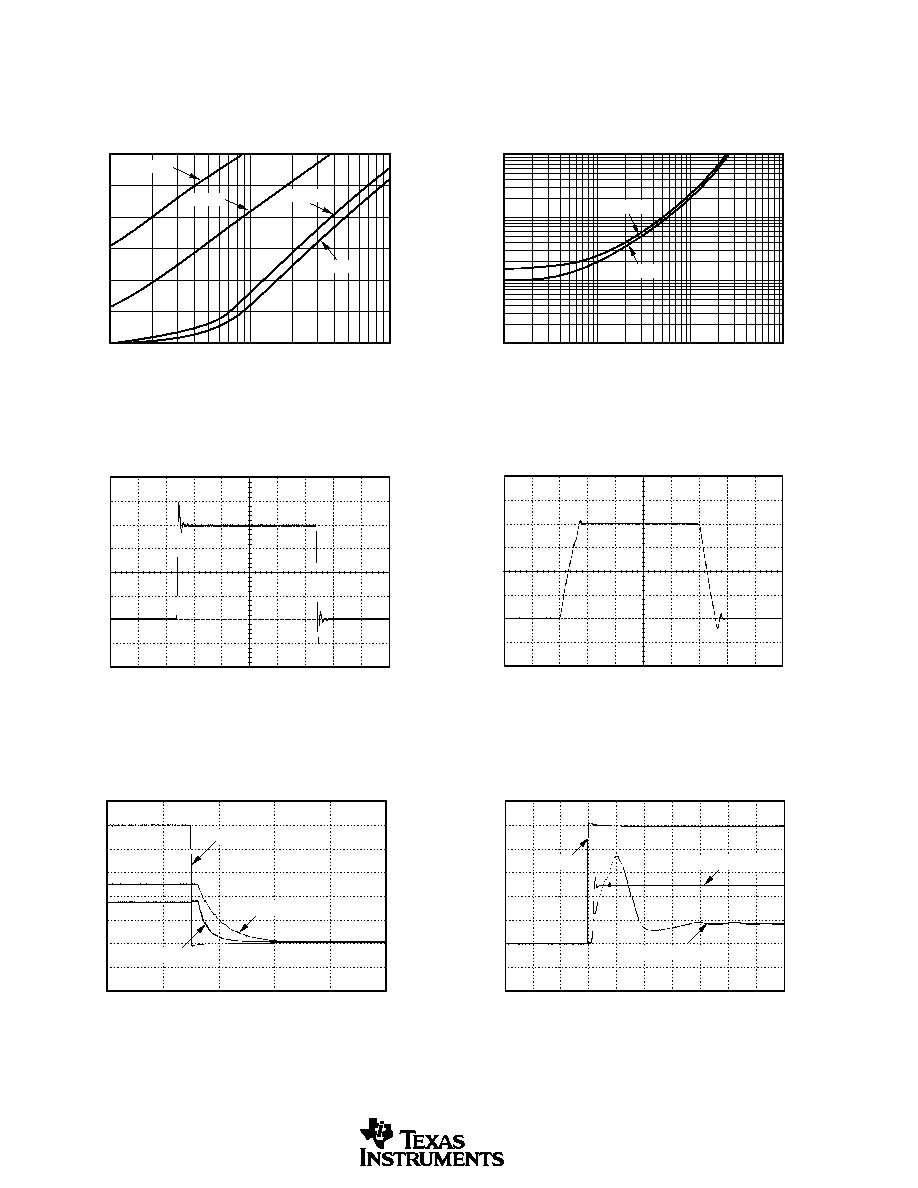
SINGLE-SUPPLY, RAIL-TO-RAIL
OPERATIONAL AMPLIFIER WITH SHUTDOWN
micro
Amplifier
TM
Series
FEATURES
q
RAIL-TO-RAIL INPUT AND OUTPUT SWING
q
Micro
SIZE PACKAGES
q
BANDWIDTH: 5.5MHz
q
SLEW RATE: 6V/
µ
s
q
QUIESCENT CURRENT: 750
µ
A/Chan
q
POWER SHUTDOWN MODE
APPLICATIONS
q
SENSOR BIASING
q
SIGNAL CONDITIONING
q
DATA ACQUISITION
q
PROCESS CONTROL
q
ACTIVE FILTERS
q
TEST EQUIPMENT
DESCRIPTION
The OPA341 series rail-to-rail CMOS operational amplifiers
are designed for low-cost, miniature applications. They are
optimized for low-voltage, single-supply operation. Rail-to-rail
input and output and high-speed operation make them ideal for
driving sampling Analog-to-Digital (A/D) converters.
The power-saving shutdown feature makes the OPA341
ideal for portable low-power applications. The OPA341
series is also well suited for general-purpose and audio
applications as well as providing I/V conversion at the
output of Digital-to-Analog (D/A) converters. Single and
dual versions have identical specifications for design flex-
ibility.
The OPA341 series operate on a single supply as low as 2.5V,
and input common-mode voltage range extends 300mV beyond
the supply rails. Output voltage swings to within 1mV of the
supply rails with a 100k
load. The OPA341 series offers
excellent dynamic response (BW = 5.5MHz, SR = 6V/
µ
s) with
a quiescent current of only 750
µ
A. The dual design features
completely independent circuitry for lowest crosstalk and free-
dom from interaction.
The single (OPA341) packages are the tiny SOT23-6 surface
mount and SO-8 surface mount. The dual (OPA2341) comes
in the miniature MSOP-10 surface mount. All are specified
from ≠55
∞
C to +125
∞
C and operate from ≠55
∞
C to +150
∞
C.
The OPA343 provides similar performance without shut-
down capability.
OPA341
OPA2341
SBOS202A ≠ AUGUST 2001
www.ti.com
PRODUCTION DATA information is current as of publication date.
Products conform to specifications per the terms of Texas Instruments
standard warranty. Production processing does not necessarily include
testing of all parameters.
Copyright © 2001, Texas Instruments Incorporated
Please be aware that an important notice concerning availability, standard warranty, and use in critical applications of
Texas Instruments semiconductor products and disclaimers thereto appears at the end of this data sheet.
1
2
3
6
5
4
V+
SD
≠In
Out
V≠
+In
OPA341
SOT23-6 (N)
1
2
3
4
8
7
6
5
SD
V+
Out
NC
NC
≠In
+In
V≠
OPA341
SO-8 (U)
1
2
3
4
5
10
9
8
7
6
V+
Out B
≠In B
+In B
SD B
Out A
≠In A
+In A
V≠
SD A
OPA2341
MSOP-10 (DGS)
OPA341
OPA2
341

OPA341, 2341
2
SBOS202A
PACKAGE
SPECIFIED
DRAWING
PACKAGE
TEMPERATURE
PACKAGE
ORDERING
TRANSPORT
PRODUCT
PACKAGE
NUMBER
DESIGNATOR
RANGE
MARKING
NUMBER
(1)
MEDIA
OPA341NA
SOT23-6
332
--
≠55
∞
C to +125
∞
C
B41
OPA341NA/250
Tape and Reel
"
"
"
--
"
"
OPA341NA/3K
Tape and Reel
OPA341UA
SO-8
182
--
≠55
∞
C to +125
∞
C
OPA341UA
OPA341UA
Rails
"
"
"
--
"
"
OPA341UA/2K5
Tape and Reel
OPA2341DGSA
MSOP-10
4073272
DGS
≠55
∞
C to +125
∞
C
C41
OPA2341DGSA/250
Tape and Reel
"
"
"
"
"
"
OPA2341DGSA/2K5
Tape and Reel
NOTE: (1) Models with a slash (/) are available only in Tape and Reel in the quantities indicated (e.g., /3K indicates 3000 devices per reel). Ordering 3000 pieces
of "OPA341NA/3K" will get a single 3000-piece Tape and Reel..
Supply Voltage, V+ to V≠ ................................................................... 6.0V
Input Voltage Range
(2)
................................... (V≠) ≠ 0.5V to (V+) + 0.5V
Input Terminal
(3)
............................................................................... 10mA
Output Short Circuit
(3)
.............................................................. Continuous
Operating Temperature .................................................. ≠55
∞
C to +150
∞
C
Storage Temperature ..................................................... ≠65
∞
C to +150
∞
C
Junction Temperature ...................................................................... 150
∞
C
Lead Temperature (soldering, 10s) ................................................. 300
∞
C
ABSOLUTE MAXIMUM RATINGS
(1)
ELECTROSTATIC
DISCHARGE SENSITIVITY
This integrated circuit can be damaged by ESD. Texas Instru-
ments recommends that all integrated circuits be handled with
appropriate precautions. Failure to observe proper handling
and installation procedures can cause damage.
ESD damage can range from subtle performance degradation
to complete device failure. Precision integrated circuits may
be more susceptible to damage because very small parametric
changes could cause the device not to meet its published
specifications.
PACKAGE/ORDERING INFORMATION
NOTES: (1) Stresses above these ratings may cause permanent damage.
Exposure to absolute maximum conditions for extended periods may de-
grade device reliability. (2) Input terminals are diode-clamped to the power
supply rails. Input signals that can swing more than 0.5V beyond the supply
rails should be current-limited to 10mA or less. (3) Short-circuit to ground,
one amplifier per package.

OPA341, 2341
3
SBOS202A
PARAMETER
CONDITION
MIN
TYP
MAX
UNITS
OFFSET VOLTAGE
Input Offset Voltage
V
OS
V
S
= 5V
±
2
±
6
mV
Drift
dV
OS
/dT
±
2
µ
V/
∞
C
vs Power Supply
PSRR
V
S
= 2.7V to 5.5V, V
CM
= 0V
40
200
µ
V/V
Over Temperature
V
S
= 2.7V to 5.5V, V
CM
= 0V
200
µ
V/V
Channel Separation, dc
0.2
µ
V/V
INPUT BIAS CURRENT
Input Bias Current
I
B
±
0.6
±
10
pA
Over Temperature
2000
pA
Input Offset Current
I
OS
±
0.2
±
10
pA
NOISE
Input Voltage Noise, f = 0.1Hz to 50kHz
8
µ
Vrms
Input Voltage Noise Density, f = 1kHz
e
n
25
nV/
Hz
Input Current Noise Density, f = 1kHz
i
n
3
fA/
Hz
INPUT VOLTAGE RANGE
(V≠) ≠ 0.3
(V+) + 0.3
V
Common-Mode Voltage Range
V
CM
(V≠) ≠ 0.1
(V+) + 0.1
V
Common-Mode Rejection Ratio
CMRR
V
S
= 5V, (V≠) ≠ 0.3V < V
CM
< (V+) ≠ 1.8V
76
90
dB
Over Temperature
V
S
= 5V, (V≠) ≠ 0.1V < V
CM
< (V+) ≠ 1.8V
74
dB
V
S
= 5V, (V≠) ≠ 0.3V
< V
CM
< (V+) + 0.3V
60
74
dB
Over Temperature
V
S
= 5V, (V≠) ≠ 0.1V
< V
CM
< (V+) + 0.1V
58
dB
V
S
= 2.7V, (V≠) ≠ 0.3V
< V
CM
< (V+) + 0.3V
57
70
dB
Over Temperature
V
S
= 2.7V, (V≠) ≠ 0.1V
< V
CM
< (V+) + 0.1V
55
dB
INPUT IMPEDANCE
Differential
10
13
|| 3
|| pF
Common-Mode
10
13
|| 6
|| pF
OPEN-LOOP GAIN
Open-Loop Voltage Gain
A
OL
R
L
= 100k
, (V≠) + 5mV < V
O
< (V+) ≠ 5mV
100
120
dB
Over Temperature
R
L
= 100k
, (V≠) + 5mV < V
O
< (V+) ≠ 5mV
100
dB
R
L
= 2k
, (V≠) + 200mV < V
O
< (V+) ≠ 200mV
96
110
dB
Over Temperature
R
L
= 2k
, (V≠) + 200mV < V
O
< (V+) ≠ 200mV
94
dB
FREQUENCY RESPONSE
V
S
= 5V
Gain-Bandwidth Product
GBW
5.5
MHz
Slew Rate
SR
G = +1, C
L
= 100pF
6
V/
µ
s
Settling Time, 0.1%
t
S
V
S
= 5V, 2V Step, G = +1, C
L
= 100pF
1
µ
s
0.01%
V
S
= 5V, 2V Step, G = +1, C
L
= 100pF
1.6
µ
s
Overload Recovery Time
V
IN
∑ Gain
V
S
0.2
µ
s
Total Harmonic Distortion + Noise
THD+N
V
S
= 5V, V
O
= 3Vp-p
(1)
, G = +1, f = 1kHz
0.0007
%
OUTPUT
Voltage Output Swing from Rail
R
L
= 100k
, A
OL
>
100dB
1
5
mV
Over Temperature
R
L
= 100k
, A
OL
>
100dB
5
mV
R
L
= 2k
,
A
OL
>
96dB
40
200
mV
Over Temperature
R
L
= 2k
, A
OL
>
94dB
200
mV
Short-Circuit Current
I
SC
±
50
mA
Capacitive Load Drive
C
LOAD
See Typical Characteristics
SHUTDOWN
t
OFF
1
µ
s
t
ON
3
µ
s
V
L
(Shutdown)
V≠
(V≠) + 0.8
V
V
H
(Amplifier is Active)
(V≠) + 2
V+
V
I
QSD
10
nA
POWER SUPPLY
Specified Voltage Range
V
S
2.7
5.5
V
Operating Voltage Range
2.5 to 5.5
V
Quiescent Current (per amplifier)
I
Q
I
O
= 0, V
S
= 5V
0.75
1.0
mA
Over Temperature
1.2
mA
TEMPERATURE RANGE
Specified Range
≠55
125
∞
C
Operating Range
≠55
150
∞
C
Storage Range
≠65
150
∞
C
Thermal Resistance
JA
∞
C/W
SOT-23-6 Surface Mount
200
∞
C/W
MSOP-10 Surface Mount
150
∞
C/W
SO-8 Surface Mount
150
∞
C/W
OPA341NA, UA
OPA2341DGSA
ELECTRICAL CHARACTERISTICS: V
S
= 2.7V to 5.5V
Boldface limits apply over the specified temperature range, T
A
= ≠55
∞
C to +125
∞
C.
At T
A
= +25
∞
C, R
L
= 10k
connected to V
S
/ 2 and V
OUT
= V
S
/ 2, V
ENABLE
= V
DD
, unless otherwise noted.
NOTE: (1) V
OUT
= 0.25V to 3.25V.

OPA341, 2341
4
SBOS202A
TYPICAL CHARACTERISTICS
At T
A
= +25
∞
C, V
ENABLE
= V
DD
, V
S
= +5V, R
L
= 10k
, unless otherwise noted.
OPEN-LOOP GAIN/PHASE vs FREQUENCY
0.1
1
160
140
120
100
80
60
40
20
0
≠20
A
OL
(dB)
0
≠45
≠90
≠135
≠180
Phase (
∞
)
Frequency (Hz)
10
100
1k
10k
100k
1M
10M
POWER-SUPPLY AND COMMON-MODE
REJECTION vs FREQUENCY
100
80
60
40
20
0
PSRR, CMRR (dB)
Frequency (Hz)
1
10
100
1k
10k
100k
1M
PSRR
CMRR
V
CM
= ≠0.3V to (V+) ≠1.8V
INPUT VOLTAGE AND CURRENT NOISE
SPECTRAL DENSITY vs FREQUENCY
10k
1k
100
10
1
1k
100
10
1
0.1
Voltage Noise (nV
Hz)
Frequency (Hz)
1
10
100
1k
10k
100k
1M
Current Noise (fA
Hz)
Current Noise
Voltage Noise
TOTAL HARMONIC DISTORTION + NOISE
vs FREQUENCY
0.1
0.01
0.001
0.0001
THD+N (%)
Frequency (Hz)
20
100
1k
10k
20k
R
L
= 600
G = 10
G = 1
R
L
= 2k
R
L
= 2k
R
L
= 10k
R
L
= 600
R
L
= 10k
CLOSED-LOOP OUTPUT RESISTANCE
vs FREQUENCY
20000
15000
10000
5000
0
Output Resistance (
)
Frequency (Hz)
10
1k
100k
1M
G = 100
G = 10
G = 1
CHANNEL SEPARATION vs FREQUENCY
Frequency (Hz)
Channel Separation (dB)
150
140
130
120
110
100
90
80
70
60
100
10
1k
10k
100k
V
S
= 2.7V

OPA341, 2341
5
SBOS202A
TYPICAL CHARACTERISTICS
(Cont.)
At T
A
= +25
∞
C, V
ENABLE
= V
DD
, V
S
= +5V, R
L
= 10k
, unless otherwise noted.
OPEN-LOOP GAIN AND PSRR
vs TEMPERATURE
160
140
120
100
80
60
40
A
OL
, CMRR, PSRR (dB)
Temperature (
∞
C)
≠75
≠25
25
75
125
150
R
L
= 100k
A
OL
A
OL
R
L
= 2k
PSRR
CMRR vs TEMPERATURE
100
90
80
70
60
CMRR (dB)
Temperature (
∞
C)
≠75
≠25
25
75
125
150
V
S
= 5V, (V≠) ≠ 0.3V < V
CM
< (V+) ≠ 1.8V
V
S
= 5V, (V≠) ≠ 0.3V < V
CM
< (V+) + 0.3V
V
S
= 2.7V, (V≠) ≠ 0.3V < V
CM
< (V+) + 0.3V
QUIESCENT CURRENT vs TEMPERATURE
1.20
1.00
0.80
0.60
0.40
0.20
0.00
Quiescent Current (mA)
Temperature (
∞
C)
≠75
≠25
25
75
125
150
QUIESCENT CURRENT vs SUPPLY VOLTAGE
0.80
0.75
0.70
0.65
0.60
Quiescent Current (mA)
Supply Voltage (V)
2
3
4
5
6
SHORT-CIRCUIT CURRENT vs TEMPERATURE
Temperature (
∞
C)
Short-Circuit Current (mA)
100
90
80
70
60
50
40
30
20
10
0
≠75
≠25
25
75
125
150
+I
SC
≠I
SC
SHORT-CIRCUIT CURRENT vs SUPPLY VOLTAGE
Supply Voltage (V)
Short-Circuit Current (mA)
60
58
56
54
52
50
48
46
44
42
40
2
3
4
5
6
+I
SC
≠I
SC

OPA341, 2341
6
SBOS202A
TYPICAL CHARACTERISTICS
(Cont.)
At T
A
= +25
∞
C, V
ENABLE
= V
DD
, V
S
= +5V, R
L
= 10k
, unless otherwise noted.
INPUT BIAS CURRENT
vs INPUT COMMON-MODE VOLTAGE
Common-Mode Voltage (V)
Input Bias Current (pA)
2
1.5
1
0.5
0
≠0.5
≠1
≠1
0
1
2
3
4
5
6
OUTPUT VOLTAGE SWING vs OUTPUT CURRENT
Output Current (mA)
Output Voltage (V)
5
4
3
2
1
0
0
±
10
±
20
±
30
±
40
±
50
±
60
±
70
±
80
±
90
±
100
+125
∞
C
+25
∞
C
≠55
∞
C
+125
∞
C
+25
∞
C
≠55
∞
C
MAXIMUM OUTPUT VOLTAGE vs FREQUENCY
10M
1M
Frequency (Hz)
100k
6
5
4
3
2
1
0
Output Voltage (Vp-p)
V
S
= 5.5V
V
S
= 2.7V
Maximum output
voltage without
slew rate-induced
distortion.
V
OS
DRIFT DISTRIBUTION
Percent of Amplifiers (%)
Offset Voltage Drift (
µ
V/
∞
C)
0.5
12.5
35
30
25
20
15
10
5
0
1.5 2.5 3.5
4.5 5.5 6.5 7.5 8.5 9.5 10.5 11.5
Typical distribution
of packaged units.
INPUT BIAS vs TEMPERATURE
10000
1000
100
10
1
0.1
Input Bias Current (pA)
150
25
75
125
Temperature (
∞
C)
≠75
≠25
V
OS
PRODUCTION DISTRIBUTION
Percent of Amplifiers (%)
Offset Voltage (mV)
≠6
6
25
20
15
10
5
0
≠5
≠4 ≠3
≠2 ≠1
0
1
2
3
4
5
Typical distribution
of packaged units.

OPA341, 2341
7
SBOS202A
TYPICAL CHARACTERISTICS
(Cont.)
At T
A
= +25
∞
C, V
ENABLE
= V
DD
, V
S
= +5V, R
L
= 10k
, unless otherwise noted.
SHUTDOWN CURRENT vs TEMPERATURE
150
25
75
125
Temperature (
∞
C)
≠75
≠25
20
15
10
5
0
Shutdown Current (nA)
V
ENABLE
= V
SS
SHUTDOWN CURRENT vs POWER SUPPLY
6
4
5
Supply Voltage (V)
2
3
12
11
10
9
8
7
6
5
4
Shutdown Current (pA)
V
ENABLE
= V
SS
SHUTDOWN CURRENT vs POWER SUPPLY
3.25
3.00
2.75
2.50
Shutdown Current (nA)
Supply Voltage (V)
2
3
4
5
6
V
ENABLE
= V
SS
+ 0.8V
SHUTDOWN CURRENT vs SHUTDOWN VOLTAGE
V
ENABLE
(V)
Shutdown Current (nA)
35
30
25
20
15
10
5
0
0.0
0.2
0.4
0.6
0.8
1.0
V
S
= 5V
QUIESCENT CURRENT vs V
ENABLE
V
ENABLE
(V)
Quiescent Current (mA)
0.8
0.7
0.6
0.5
0.4
0.3
0.2
0.1
0
0.0
0.4
0.8
1.2
1.6
2.0
V
S
= 2.7V
QUIESCENT CURRENT vs V
ENABLE
V
ENABLE
(V)
Quiescent Current (mA)
0.8
0.7
0.6
0.5
0.4
0.3
0.2
0.1
0
0.0
0.4
0.8
1.2
1.6
2.0
V
S
= 5.5V

OPA341, 2341
8
SBOS202A
TYPICAL CHARACTERISTICS
(Cont.)
At T
A
= +25
∞
C, V
ENABLE
= V
DD
, V
S
= +5V, R
L
= 10k
, unless otherwise noted.
SMALL-SIGNAL OVERSHOOT
vs LOAD CAPACITANCE
10k
1k
Load Capacitance (pF)
100
60
50
40
30
20
10
0
Overshoot (%)
G = +1
G = ≠1
G = +5
G = ≠5
SETTLING TIME vs CLOSED-LOOP GAIN
(2VStep G = +1)
100
10
1
0.1
Settling Time (
µ
s)
Closed-Loop Gain (V/V)
1
10
100
1000
0.1%
0.01%
SMALL-SIGNAL STEP RESPONSE
50mV/div
1
µ
s/div
LARGE-SIGNAL STEP RESPONSE
1V/div
1
µ
s/div
SHUT-DOWN RESPONSE
1V/div
500
µ
A/div
2
µ
s/div
V
ENABLE
Output Voltage
Supply Current
TURN-ON RESPONSE
1V/div
1mA/div
2
µ
s/div
V
ENABLE
Output Voltage
Supply Current

OPA341, 2341
9
SBOS202A
FIGURE 2. Simplified Schematic.
APPLICATIONS INFORMATION
OPA341 series op amps are fabricated on a state-of-the-art
0.6-micron CMOS process. They are unity-gain stable and
suitable for a wide range of general-purpose applications.
Rail-to-rail I/O make them ideal for driving sampling A/D
converters. In addition, excellent ac performance makes
them well suited for audio applications. The class AB output
stage is capable of driving 600
loads connected to any point
between V+ and ground. Rail-to-rail input and output swing
significantly increases dynamic range, especially in low-
supply applications. Figure 1 shows the input and output
waveforms for the OPA341 in unity-gain configuration.
Operation is from a single +5V supply with a 10k
load
connected to V
S
/2. The input is a 5Vp-p sinusoid. Output
voltage is approximately 4.98Vp-p. Power-supply pins should
be bypassed with 0.01
µ
F ceramic capacitors.
OPERATING VOLTAGE
OPA341 series op amps are fully specified from +2.7V to
+5.5V. However, supply voltage may range from +2.5V to
+5.5V. Parameters are tested over the specified supply
range--a unique feature of the OPA341 series. In addition,
many specifications apply from ≠55
∞
C to +125
∞
C. Most
behavior remains virtually unchanged throughout the full
operating voltage range. Parameters that vary significantly
with operating voltages or temperature are shown in the
Typical Characteristics.
RAIL-TO-RAIL INPUT
The input common-mode voltage range of the OPA341
series extends 300mV beyond the supply rails. This is achieved
with a complementary input stage--an N-channel input dif-
ferential pair in parallel with a P-channel differential pair, as
shown in Figure 2. The N-channel pair is active for input
voltages close to the positive rail, typically (V+) ≠ 1.3V to
300mV above the positive supply. The P-channel pair is on
for inputs from 300mV below the negative supply to approxi-
mately (V+) ≠ 1.3V.
There is a small transition region, typically (V+) ≠ 1.5V to
(V+) ≠ 1.1V, in which both input pairs are on. This 400mV
transition region can vary
±
300mV with process variation.
Thus, the transition region (both stages on) can range from
(V+) ≠ 1.8V to (V+) ≠ 1.4V on the low end, up to (V+) ≠ 1.2V
to (V+) ≠ 0.8V on the high end. Within the 400mV transition
region PSRR, CMRR, offset voltage, offset drift, and THD
may be degraded compared to operation outside this region.
FIGURE 1. Rail-to-Rail Input and Output.
V
S
= 5, G = +1, R
L
= 10k
20
µ
s/div
V
IN
2V/div
V
OUT
V
BIAS1
V
BIAS2
V
IN
+
V
IN
≠
Class AB
Control
Circuitry
V
O
V≠
(Ground)
ENABLE (CMOS Input)
On = High
Off = Low
V+
Reference
Current

OPA341, 2341
10
SBOS202A
FIGURE 3. Input Current Protection for Voltages Exceeding
the Supply Voltage.
FIGURE 4. Series Resistor in Unity-Gain Configuration Improves Capacitive Load Drive.
A double-folded cascode adds the signal from the two input
pairs and presents a differential signal to the class AB output
stage. Normally, input bias current is approximately 600fA,
however, input voltages exceeding the power supplies by
more than 300mV can cause excessive current to flow in or
out of the input pins. Momentary voltages greater than
300mV beyond the power supply can be tolerated if the
current on the input pins is limited to 10mA. This is easily
accomplished with an input resistor, as shown in Figure 3.
Many input signals are inherently current-limited to less
than 10mA, therefore, a limiting resistor is not required.
RAIL-TO-RAIL OUTPUT
A class AB output stage with common-source transistors is
used to achieve rail-to-rail output. For light resistive loads
(> 50k
), the output voltage is typically a few millivolts
from the supply rails. With moderate resistive loads (2k
to
50k
), the output can swing to within a few tens of milli-
volts from the supply rails and maintain high open-loop
gain. See the typical characteristic "Output Voltage Swing
vs Output Current."
CAPACITIVE LOAD AND STABILITY
OPA341 series op amps can drive a wide range of capacitive
loads. However, all op amps under certain conditions may
become unstable. Op amp configurations, gain, and load
value are just a few of the factors to consider when determin-
ing stability. An op amp in unity-gain configuration is the
most susceptible to the effects of capacitive load. The
capacitive load reacts with the op amp's output resistance,
along with any additional load resistance, to create a pole in
the small-signal response which degrades the phase margin.
In unity gain, OPA341 series op amps perform well, with a
pure capacitive load up to approximately 1000pF. Increasing
gain enhances the amplifier's ability to drive more capaci-
tance. See the typical characteristic "Small-Signal Over-
shoot vs Capacitive Load."
One method of improving capacitive load drive in the unity-
gain configuration is to insert a 10
to 20
resistor in series
with the output, as shown in Figure 4. This significantly
reduces ringing with large capacitive loads. However, if there
is a resistive load in parallel with the capacitive load, R
S
creates a voltage divider. This introduces a DC error at the
output and slightly reduces output swing. This error may be
insignificant. For instance, with R
L
= 10k
and R
S
= 20
,
there is only about a 0.2% error at the output.
DRIVING A/D CONVERTERS
OPA341 series op amps are optimized for driving medium
speed (up to 100kHz) sampling A/D converters. However,
they also offer excellent performance for higher-speed con-
verters. The OPA341 series provides an effective means of
buffering the A/D converter's input capacitance and result-
ing charge injection while providing signal gain. For appli-
cations requiring high accuracy, the OPA340 series is rec-
ommended.
The OPA341 implements a power-saving shutdown feature
particularly useful for low-power sampling applications. Figure 5
shows the OPA341 driving the ADS7816, a 12-bit micro-power
sampling converter available in the tiny MSOP-8 package. With
the OPA341 in non-inverting configuration, an RC network at the
amplifier's output is used as an anti-aliasing filter. By tying the
enable of the OPA341 to the shutdown of the ADS7816, addi-
tional power-savings can be used for sampling applications. To
effectively drive the ADS7816, timing delay was introduced
between the two devices, see Figure 5. Alternative applications
may need additional timing adjustments.
Figure 6 shows the OPA341 configured as a speech band-
pass filter. Figure 7 shows the OPA341 configured as a
transimpedance amplifier.
OPAx341
10mA max
V+
V
IN
V
OUT
I
OVERLOAD
10
to
20
OPAx341
V+
V
ENABLE
V
IN
V
OUT
R
S
R
L
C
L

OPA341, 2341
11
SBOS202A
FIGURE 7. Transimpedance Amplifier.
FIGURE 5. OPA341 in Noninverting Configuration Driving the ADS7816 with Timing Diagram.
FIGURE 6. Speech Bandpass Filter.
ADS7816
12-Bit A/D
Converter
DCLOCK
D
OUT
CS/SHDN
OPA341
+5V
V
IN
V+
2
+In
3
≠In
V
REF
8
4
GND
Serial
Interface
1
0.1
µ
F
0.1
µ
F
7
6
5
NOTE: A/D Input = 0 to V
REF
V
IN
= 0V to 5V for
0V to 5V output.
500
3300pF
10k
ENABLE
Timing
Logic
1.6
µ
s
OA
Enable
3
µ
s
OA
Settling
15
µ
s
Anti-Aliasing Filter Settling
RC Anti-Aliasing
Filter
OPA341 SD
ADS7816 CS/SHDN
1
µ
s
5
µ
s
243k
10M
10M
1.74M
220pF
47pF
200pF
1/2
OPA2341
+5V
ENABLE A
ENABLE B
V
IN
R
L
1/2
OPA2341
Filters 160Hz to 2.4kHz
OPA341
V
O
10M
< 1pF (prevents gain peaking)
V+
ENABLE

PACKAGING INFORMATION
ORDERABLE DEVICE
STATUS(1)
PACKAGE TYPE
PACKAGE DRAWING
PINS
PACKAGE QTY
OPA2341DGSA/250
ACTIVE
VSSOP
DGS
10
250
OPA2341DGSA/2K5
ACTIVE
VSSOP
DGS
10
2500
OPA341NA/250
ACTIVE
SOP
DBV
6
250
OPA341NA/3K
ACTIVE
SOP
DBV
6
3000
OPA341UA
ACTIVE
SOIC
D
8
100
OPA341UA/2K5
ACTIVE
SOIC
D
8
2500
(1) The marketing status values are defined as follows:
ACTIVE: Product device recommended for new designs.
LIFEBUY: TI has announced that the device will be discontinued, and a lifetime-buy period is in effect.
NRND: Not recommended for new designs. Device is in production to support existing customers, but TI does not recommend using this part in
a new design.
PREVIEW: Device has been announced but is not in production. Samples may or may not be available.
OBSOLETE: TI has discontinued the production of the device.
PACKAGE OPTION ADDENDUM
www.ti.com
3-Oct-2003

IMPORTANT NOTICE
Texas Instruments Incorporated and its subsidiaries (TI) reserve the right to make corrections, modifications,
enhancements, improvements, and other changes to its products and services at any time and to discontinue
any product or service without notice. Customers should obtain the latest relevant information before placing
orders and should verify that such information is current and complete. All products are sold subject to TI's terms
and conditions of sale supplied at the time of order acknowledgment.
TI warrants performance of its hardware products to the specifications applicable at the time of sale in
accordance with TI's standard warranty. Testing and other quality control techniques are used to the extent TI
deems necessary to support this warranty. Except where mandated by government requirements, testing of all
parameters of each product is not necessarily performed.
TI assumes no liability for applications assistance or customer product design. Customers are responsible for
their products and applications using TI components. To minimize the risks associated with customer products
and applications, customers should provide adequate design and operating safeguards.
TI does not warrant or represent that any license, either express or implied, is granted under any TI patent right,
copyright, mask work right, or other TI intellectual property right relating to any combination, machine, or process
in which TI products or services are used. Information published by TI regarding third-party products or services
does not constitute a license from TI to use such products or services or a warranty or endorsement thereof.
Use of such information may require a license from a third party under the patents or other intellectual property
of the third party, or a license from TI under the patents or other intellectual property of TI.
Reproduction of information in TI data books or data sheets is permissible only if reproduction is without
alteration and is accompanied by all associated warranties, conditions, limitations, and notices. Reproduction
of this information with alteration is an unfair and deceptive business practice. TI is not responsible or liable for
such altered documentation.
Resale of TI products or services with statements different from or beyond the parameters stated by TI for that
product or service voids all express and any implied warranties for the associated TI product or service and
is an unfair and deceptive business practice. TI is not responsible or liable for any such statements.
Following are URLs where you can obtain information on other Texas Instruments products and application
solutions:
Products
Applications
Amplifiers
amplifier.ti.com
Audio
www.ti.com/audio
Data Converters
dataconverter.ti.com
Automotive
www.ti.com/automotive
DSP
dsp.ti.com
Broadband
www.ti.com/broadband
Interface
interface.ti.com
Digital Control
www.ti.com/digitalcontrol
Logic
logic.ti.com
Military
www.ti.com/military
Power Mgmt
power.ti.com
Optical Networking
www.ti.com/opticalnetwork
Microcontrollers
microcontroller.ti.com
Security
www.ti.com/security
Telephony
www.ti.com/telephony
Video & Imaging
www.ti.com/video
Wireless
www.ti.com/wireless
Mailing Address:
Texas Instruments
Post Office Box 655303 Dallas, Texas 75265
Copyright
2003, Texas Instruments Incorporated












